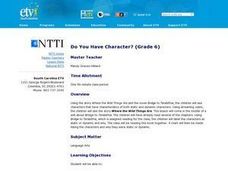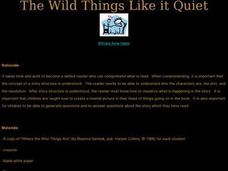Curated OER
Do You Prefer Your Children's Book Characters Obedient or Contrary? Opinion Writing
With this New York Times "Learning Network" exercise, high schoolers read an article about the death of Maurice Sendak, author of Where the Wild Things Are and then respond to several prompts that require them to shape their own opinions...
Curated OER
Going Graph-y
Second graders listen to and dicuss the story Where the Wild Things Are. They play a pantomime game and act out various feelings so their classmates can guess. They listen for the frequency of certain words, and record their findings on...
Curated OER
It's All About Expression: Growing Independence and Fluency
In an engaging anticipatory set, the teacher uses several different strategies to activate prior knowledge about reading with expression, including using sentence strips (that must be prepped ahead of time) to show different moods. The...
Curated OER
Do You Have Character?
Sixth graders read Katherine Paterson's novel, Bridge to Terabithia, and watch a video of Maurice Sendak's book, Where the Wild Things Are. They examine the characters in both stories that share similar characteristics. Students use the...
Curated OER
The Wild Things Like it Quiet
Students read Where the Wild Things Are by Maurice Sendak. They visualize what is happening in the book and then identify the main points of the story. Students write a summary of the book and draw a picture of what they visualized...
Curated OER
Where the Red Fern Grows Chapter 13
In this reading comprehension worksheet, students answer 12 multiple choice questions that pertain to chapter 13 of Where the Red Fern Grows by Wilson Rawls.
Curated OER
Where the Wild Things Are
In this online interactive reading comprehension worksheet, learners respond to 11 multiple choice questions regarding Where the Wild Things Are.
Curated OER
Where the Wild Things Are...Teacher's Bags, Books, and Beyond
In these Where the Wild Things Are worksheets, students complete a series of different activities for the text. Students complete addition, subtraction, math word problems, printing practice, and time telling activities.
Curated OER
What Are We Reading for Again?
Students work to develop comprehension strategies. Through modeling and guided practice they develop a series of questions as they read Where the Wild Things Are. They apply these questions to find answers about the text and make...
Curated OER
Stepping Stones
Students listen to stories read aloud. They examine a work of art by a known artist. Students take a picture using the digital camera. They listen as the teacher reads "Where the Wild Things Are." Students compare and contrast the...
Curated OER
Monster Voices
Students create stories based upon the techniques of author Maurice Sendak in Where the Wild Things Are. They use a word processing program and the Apple software program GarageBand to create new voices for the story. This lesson plan...
Curated OER
Writing for Different Purposes and Audiences
Third graders explore how to write for different purposes and for a specific audience or person. They read, Where the Wild Things Are by Maurice Sendak. Students create a class book after reading the story. They each create their own...
Curated OER
Visualizing While Reading
Third graders listen to the story Where the Wild Things Are, and draw pictures to illustrate what they think is happening. Students share their visualizations with their partners.
Curated OER
Wild Things
Students draw a literacy response picture demonstrating knowledge and appropriate use of computer hardware components (monitor, mouse) using KidPix and Kidspiration software with a minimum of two different pictorial details on their...
Curated OER
Wild Things - Texture And Pattern
Students implement textures and patterns in creating an imaginary Wild Thing, using the book and illustrations in Where the Wild Things Are by Maurice Sendak serve as Inspiration.
Curated OER
Where the Wild Things Are Activity Card
In this reading worksheet, students respond to the book Where the Wild Things Are by completing an activity at home. Students draw a picture of a terrible monster, pretend to be Max and tame the monster.

















